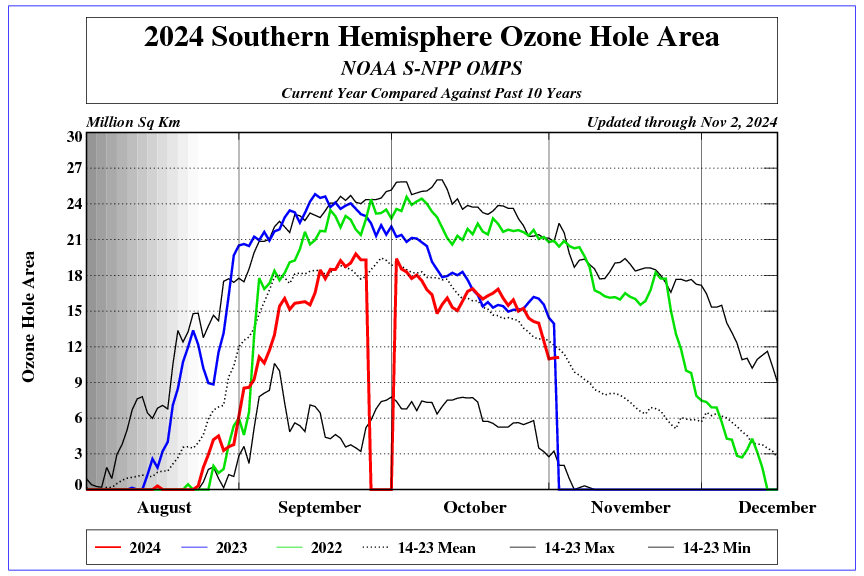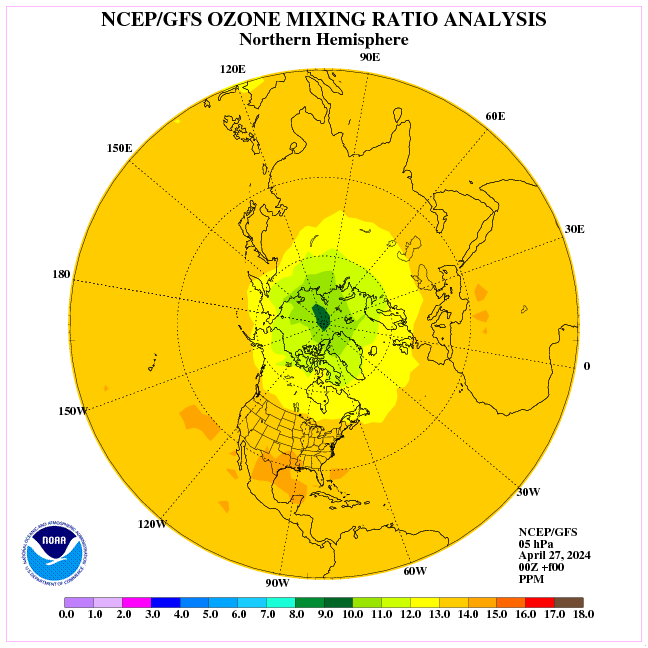Whether this tells us anything about long-term climate trends is not clear, but worth a mention anyway. The report from Phys.org states: ‘Scientists said the smaller ozone hole extent in 2016 and 2017 is due to natural variability and not a signal of rapid healing’.
Measurements from satellites this year showed the hole in Earth’s ozone layer that forms over Antarctica each September was the smallest observed since 1988, scientists from NASA and NOAA announced today.
According to NASA, the ozone hole reached its peak extent on Sept. 11, covering an area about two and a half times the size of the United States – 7.6 million square miles in extent – and then declined through the remainder of September and into October.
NOAA ground- and balloon-based measurements also showed the least amount of ozone depletion above the continent during the peak of the ozone depletion cycle since 1988.
NOAA and NASA collaborate to monitor the growth and recovery of the ozone hole every year. “The Antarctic ozone hole was exceptionally weak this year,” said Paul A. Newman, chief scientist for Earth Sciences at NASA’s Goddard Space Flight Center in Greenbelt, Maryland. “This is what we would expect to see given the weather conditions in the Antarctic stratosphere.”
The smaller ozone hole in 2017 was strongly influenced by an unstable and warmer Antarctic vortex – the stratospheric low pressure system that rotates clockwise in the atmosphere above Antarctica.
This helped minimize polar stratospheric cloud formation in the lower stratosphere. The formation and persistence of these clouds are important first steps leading to the chlorine- and bromine-catalyzed reactions that destroy ozone, scientists said. These Antarctic conditions resemble those found in the Arctic, where ozone depletion is much less severe. In 2016, warmer stratospheric temperatures also constrained the growth of the ozone hole.
Last year, the ozone hole reached a maximum 8.9 million square miles, 2 million square miles less than in 2015. The average area of these daily ozone hole maximums observed since 1991 has been roughly 10 million square miles.
Continued here.







The Ozone Hole has been cycling forever. Another alarmist scare. This one was to get rid of R12 because the patent had run out and it was too cheap for the big companies to make money.
They had to get it off the marked and bring out new products that were patented, even though they were not as good for cooling. At the peak of the ozone hole scare, the ozone hole closed some even before the R12 ban was effective.
Thanks CO2!
On Mars Ozone partial pressure peaks at the surface. There is no life in the soil of Mars to emit oxides of nitrogen to exert a chemical control on ozone.
On Earth the troposphere above the soil rich northern hemisphere is higher than in the southern hemisphere.
In winter, a down-draft of cold stratospheric and mesospheric air over Antarctica maintains high levels of ozone. The air is very cold. There is no tropopause…no reversal of the lapse rate of temperature with altitude until the 10hPa level.
In Spring ,with the return of the sun the upper atmosphere above Antarctica warms. This slows and stops descent. A sphincter of NOx rich air from the troposphere gradually closes in at 50hPa as stratospheric air begins to ascend rather than descend. The circulation of the upper air then reverses from clockwise as seen from above the pole to anticlockwise.
The ozone hole in spring is natural.It is an artefact of the global distribution of land and sea.See https://reality348.wordpress.com/2016/05/14/23-the-dearly-beloved-antarctic-ozone-hole-a-function-of-atmospheric-dynamics/
Using Dobsons spectrometer researchers observed the ozone hole above Antarctica in the 1950s. They were astounded because there was no such thing in the Arctic. Repeated observations confirmed its presence every year. This was long before the advent of household refrigeration and air conditioning.
erl happ…….Thanks! Ozone holes are natural and normal events and freon did not cause them.
“The report from Phys.org states: ‘Scientists said the smaller ozone hole extent in 2016 and 2017 is due to natural variability and not a signal of rapid healing’.”
This statement just shows warped thinking at work. Nothing has to heal. An ozone hole is NOT an atmospheric scar. The ozone does what it does, it appears to be quite natural for it to vary — to thin, or have a hole, or at other times not.
We humans are not in command of this atmospheric effect.
As Erl Happ says above “Using Dobsons spectrometer researchers observed the ozone hole above Antarctica in the 1950s…Repeated observations confirmed its presence every year. This was long before the advent of household refrigeration and air conditioning.”
tom0mason wrote: This statement just shows warped thinking at work. Nothing has to heal. An ozone hole is NOT an atmospheric scar. The ozone does what it does, it appears to be quite natural for it to vary — to thin, or have a hole, or at other times not.
We humans are not in command of this atmospheric effect.
Thanks, this is sensible!!!
Thank-you Mr. Pope…
You are “Herman Alexander (Alex) Pope, a retired NASA-JSC engineer, began his career as a Co-op student at the Manned Spacecraft Center in Houston Texas in 1963 and concurrently earned a BS degree in Engineering Mechanics from Virginia Tech in 1967. Mr. Pope supplied computer analysis to the
Gemini, Apollo, Space Shuttle, Space Station, X-38 and other missions and projects between 1963-
2007. “?
tom0mason Yes that is me.
http://www.popesclimatetheory.com
https://www.dropbox.com/s/96ye3p77eq9pnjf/Alex%20Pope%20-%20Ice%20on%20Land%20-%202017%20Oct%2021.pptx?dl=0
First detected in 1985, the Antarctic ozone hole forms during the Southern Hemisphere’s late winter as the returning sun’s rays catalyze reactions involving man-made, chemically active forms of chlorine and bromine. These reactions destroy ozone molecules.
Read more at: https://phys.org/news/2017-11-air-ozone-hole-smallest.html#jCp
Phys.org article is a rehash of the old and boring litany fed to the public since the early 70s. The Litany insists on the absurd claim that ozone is affected by manmade compounds, when the only reason is purely physical, or dynamic. The truth about the ozone issue is:
1) It was not first detected in 1985, but ozone level decreases have been detected since scientists began researching the subject, as far back a 1929. Norwegians were monitoring ozone levels above Dombas and Oslo, and readings are easily found in Norway’s databases. Back in 1957, during the International Geophysical Year George Dobson’s team measured ozone levels as low as 1125 DU, while on the other side of Antarctica, Leroy and Rigaud measured the same levels.
2) The truth is: ozone is the most unstable gas on Earth. Two ozone molecules touch each other and become 3 oxygen molecules and ozone concentrations plummet without any chemical taking any part on it. The stratospheric polar vortex with winds up to 400 k/h, shake and stir all kind of molecules inside it. Once the vortex is formed at the beginning of winter, ozone molecules collide against all other gaseous molecules but only react with the ozone ones… stratosphere temperatures below -80º C makes it almost impossible any kind of chemical reactions.
3) As the vortex winds play havoc on ozone molecules, sending them back to the oxygen state, O3 + O3 3 O2, instruments start to measure a fast decrease in ozone. As this is happening in total darkness, and no UV-C radiation reaches the top of Antarctica stratosphere the production of ozone does not exist: Only UV-C radiation can split oxygen molecules in order to free two ozone atoms: O2 + UV-C = 2 O+. But then about September 10 – 15, solar radiation starts to reach the topmost part of Antarctica’s stratosphere, and thus ozone formation begins to take place and, of course, instruments read: ozone stopped decreasing.
4) And from there on, ozone levels keep increasing and the ozone layer is replenished. In the meantime, all chemical reactions occur at such low speed that they are meaningless. Of course, there is no such action of CFC releasing chlorine (or OCLO) because CFCs, as N2 and O2, can only be dissociated by UV-C wavelength (290 nm or less) that is not found below 40 km altitude. Measurements made by R. Fabian, S.S. Borders, and S. Penkett, “Halocarbons in the Stratosphere”, (Nature, Dec. 24, 1981) found CF2Cl2 and F-12 molecules at 32 km altitude at 10 ppTrillion, while F-11 and CF3Br and other CFCs molecules were found at 32 km at 0.1 ppTrillion.
5) So neither Chlorine, Bromine or CFCs have any role in the reduction of ozone layer levels. And I don’t want to get into the fake Mario Molina’s Ozone dimer theory, (that made him win a shameful Nobel Prize in 1985) because this comment is already quite long.
The ears of ‘official ozone science’ should be burning 🙂
There was a period of unusual solar activity (flares /wind) in this period. If this augmented the Brewer – Dobson circulation then the “ozone hole” would be affected (shrink) as well.
Why was this high pressure unlike others before it?
Report: Freeview blames air pressure for TV disruption
1 November 2017
Freeview has said that high air pressure is the cause of disruption being experienced by some of its users in England and Wales.
The service provides access to digital TV channels through aerials, making it possible to watch programmes without a satellite or cable subscription.
http://www.bbc.co.uk/news/technology-41836518
Not sure why the News of less cold results in smaller Antarctic Ozone depletion hole. This was known years before the Mime of Refrigerant caused depletion became a fashionable part of the AGW Religion…pg
@Herman Alexander Pope thank-you.
Is the chart below you can see the human impact?

In my opinion you can see the influence of the magnetic activity of the Sun.
It is interesting to shift the stratospheric polar vortex towards Europe.


North America is exposed to the Arctic air.
Winter in Canada.

Cold records shattered in British Columbia.
November 3, 2017
Record Low Temperatures for November 3 – More than a foot of snow in some areas:
Puntzi Mountain, B.C.: -22.4C (-8.3 F) shatters old record of -18.7C (-1.7 F) set in 2003
Williams Lake, B.C.: -15.4C (4.3 F) shatters old record of -10.0C (14.0 F) set in 1973
http://www.iceagenow.info/cold-records-shattered-british-columbia/
Just right for Hollywood climate alarmists 😎